Burrow-Nesting Seabird Survey Using UAV-Mounted Thermal Sensor and Count Automation
Abstract
:1. Introduction
2. Materials and Methods
2.1. Study Site
2.2. UAV and Flight Planning
2.3. Thermal Sensor
2.4. Field Operations
2.5. Ground Validation
2.6. Thermal Orthomosaic Image Processing
2.7. Study Area Boundary Definition
2.8. Manual Counts
2.9. Count Automation
2.9.1. Clustering
2.9.2. Image Window Size and Selection
2.9.3. Validation of Count Automation
2.9.4. Python Libraries Used for Image Analysis
2.10. Survey Methodology and Data Collection
3. Results
3.1. Manual and Automated Counts
3.1.1. Digital Number Distribution Analysis
3.1.2. Automated Counts
3.1.3. Comparisons between Automated and Manual Counts
3.2. Ground Validation
4. Discussion
4.1. Field Surveys
4.2. Image Processing
4.3. Count Automation
4.4. Limitations of Thermal Sensors
5. Conclusions
Author Contributions
Funding
Data Availability Statement
Acknowledgments
Conflicts of Interest
References
- Croxall, J.P.; Butchart, S.H.M.; Lascelles, B.E.N.; Stattersfield, A.J.; Sullivan, B.E.N.; Symes, A.; Taylor, P. Seabird conservation status, threats and priority actions: A global assessment. Bird Conserv. Int. 2012, 22, 1–34. [Google Scholar] [CrossRef]
- Paleczny, M.; Hammill, E.; Karpouzi, V.; Pauly, D. Population Trend of the World’s Monitored Seabirds, 1950–2010. PLoS ONE 2015, 10, e0129342. [Google Scholar] [CrossRef] [PubMed]
- Spatz, D.R.; Newton, K.M.; Heinz, R.; Tershy, B.; Holmes, N.D.; Butchart, S.H.M.; Croll, D.A. The Biogeography of Globally Threatened Seabirds and Island Conservation Opportunities. Conserv. Biol. 2014, 28, 1282–1290. [Google Scholar] [CrossRef] [PubMed]
- Brooke, M.d.L. The food consumption of the world’s seabirds. Proc. R. Soc. Lond. Ser. B Biol. Sci. 2004, 271, S246–S248. [Google Scholar]
- Bradley, J.S.; Skira, I.J.; Wooller, R.D. A long-term study of Short-tailed Shearwaters Puffinus tenuirostris on Fisher Island, Australia. Ibis 1991, 133, 55–61. [Google Scholar] [CrossRef]
- Parker, G.C.; Rexer-Huber, K. Guidelines for Designing Burrowing Petrel Surveys to Improve Population Estimate Precision; Agreement on the Conservation of Albatrosses and Petrels Conservation Guidelines Series; Agreement on the Conservation of Albatrosses and Petrels: Hobart, Australia, 2016. [Google Scholar]
- Pearson, S.F.; Hodum, P.J.; Good, T.P.; Schrimpf, M.; Knapp, S.M. A Model Approach for Estimating Colony Size, Trends, and Habitat Associations of Burrow-Nesting Seabirds: Un Enfoque Modelo Para Estimar el Tamaño de la Colonia, las Tendencias y las Asociaciones de Habitat en Aves Marinas Que Anidan en Madrigueras. Condor 2013, 115, 356–365. [Google Scholar] [CrossRef]
- Orben, R.A.; Fleishman, A.B.; Borker, A.L.; Bridgeland, W.; Gladics, A.J.; Porquez, J.; Sanzenbacher, P.; Stephensen, S.W.; Swift, R.; McKown, M.W.; et al. Comparing imaging, acoustics, and radar to monitor Leach’s storm-petrel colonies. PeerJ 2019, 7, e6721. [Google Scholar] [CrossRef]
- Carey, M.J. Incubation routine, duration of foraging trips and regulation of body mass in Short-tailed Shearwaters (Ardenna tenuirostris). Emu—Austral. Ornithol. 2011, 111, 166–171. [Google Scholar] [CrossRef]
- Skira, I.J.; Brothers, N.P.; Pemberton, D. Distribution, abundance and conservation status of Short-tailed Shearwaters Puffinus tenuirostris in Tasmania, Australia. Mar. Ornithol. 1996, 24, 1–14. [Google Scholar]
- Skira, I.; Brothers, N. Seabird Islands No. 184: Great Dog Island, Furneaux Group, Tasmania. Corella 1988, 12, 82–84. [Google Scholar]
- Vertigan, C.A. The life-history of Short-Tailed Shearwaters (Puffinus tenuirostris) in Response to Spatio-Temporal Environmental Variation. Ph.D. Thesis, University of Tasmania, Hobart, Australia, 2010. [Google Scholar]
- Oppel, S.; Hervías-Parejo, S.; Oliveira, N.; Pipa, T.; Silva, C.; Geraldes, P.; Goh, M.; Immler, E.; McKown, M. Estimating population size of a nocturnal burrow-nesting seabird using acoustic monitoring and habitat mapping. Nat. Conserv. 2014, 7, 1–13. [Google Scholar] [CrossRef]
- Christie, K.S.; Gilbert, S.L.; Brown, C.L.; Hatfield, M.; Hanson, L. Unmanned aircraft systems in wildlife research: Current and future applications of a transformative technology. Front. Ecol. Environ. 2016, 14, 241–251. [Google Scholar] [CrossRef]
- Gómez-Candón, D.; Virlet, N.; Labbé, S.; Jolivot, A.; Regnard, J.-L. Field phenotyping of water stress at tree scale by UAV-sensed imagery: New insights for thermal acquisition and calibration. Precis. Agric. 2016, 17, 786–800. [Google Scholar] [CrossRef]
- Hoffmann, H.; Jensen, R.; Thomsen, A.; Nieto, H.; Rasmussen, J.; Friborg, T. Crop water stress maps for an entire growing season from visible and thermal UAV imagery. Biogeosciences 2016, 13, 6545–6563. [Google Scholar] [CrossRef]
- Smigaj, M.; Gaulton, R.; Suarez, J.C.; Barr, S.L. Use of miniature thermal cameras for detection of physiological stress in conifers. Remote Sens. 2017, 9, 957. [Google Scholar] [CrossRef]
- Scholten, C.; Kamphuis, A.; Vredevoogt, K.; Lee-Strydhorst, K.; Atma, J.; Shea, C.; Lamberg, O.; Proppe, D. Real-time thermal imagery from an unmanned aerial vehicle can locate ground nests of a grassland songbird at rates similar to traditional methods. Biol. Conserv. 2019, 233, 241–246. [Google Scholar] [CrossRef]
- Dickens, J.; Hollyman, P.R.; Hart, T.; Clucas, G.V.; Murphy, E.J.; Poncet, S.; Trathan, P.N.; Collins, M.A. Developing UAV Monitoring of South Georgia and the South Sandwich Islands’ Iconic Land-Based Marine Predators. Front. Mar. Sci. 2021, 8, 654215. [Google Scholar] [CrossRef]
- Drever, M.C.; Chabot, D.; O’Hara, P.D.; Thomas, J.D.; Breault, A.; Millikin, R.L. Evaluation of an unmanned rotorcraft to monitor wintering waterbirds and coastal habitats in British Columbia, Canada. J. Unmanned Veh. Syst. 2015, 3, 256–267. [Google Scholar] [CrossRef]
- Hodgson, J.C.; Mott, R.; Baylis, S.M.; Pham, T.T.; Wotherspoon, S.; Kilpatrick, A.D.; Raja Segaran, R.; Reid, I.; Terauds, A.; Koh, L.P. Drones count wildlife more accurately and precisely than humans. Methods Ecol. Evol. 2018, 9, 1160–1167. [Google Scholar] [CrossRef]
- Sardà-Palomera, F.; Bota, G.; Viñolo, C.; Pallares Valls, O.; Sazatornil, V.; Brotons, L.; Gomariz, S.; Sardà, F. Fine-scale bird monitoring from light unmanned aircraft systems. Ibis 2012, 154, 177–183. [Google Scholar] [CrossRef]
- Junda, J.; Greene, E.; Bird, D.M. Proper flight technique for using a small rotary-winged drone aircraft to safely, quickly, and accurately survey raptor nests. J. Unmanned Veh. Syst. 2015, 3, 222–236. [Google Scholar] [CrossRef]
- Albores-Barajas, Y.V.; Soldatini, C.; Ramos-Rodríguez, A.; Alcala-Santoyo, J.E.; Carmona, R.; Dell’Omo, G. A new use of technology to solve an old problem: Estimating the population size of a burrow nesting seabird. PLoS ONE 2018, 13, e0202094. [Google Scholar] [CrossRef]
- McCafferty, D.J. Applications of thermal imaging in avian science. Ibis 2013, 155, 4–15. [Google Scholar] [CrossRef]
- Lee, W.Y.; Park, M.; Hyun, C.-U. Detection of two Arctic birds in Greenland and an endangered bird in Korea using RGB and thermal cameras with an unmanned aerial vehicle (UAV). PLoS ONE 2019, 14, e0222088. [Google Scholar] [CrossRef] [PubMed]
- Israel, M.; Reinhard, A. Detecting nests of lapwing birds with the aid of a small unmanned aerial vehicle with thermal camera; 2017. In Proceedings of the International Conference on Unmanned Aircraft Systems (ICUAS), Miami, FL, USA, 13–16 June 2017; pp. 1199–1207. [Google Scholar] [CrossRef]
- Chabot, D.; Francis, C.M. Computer-automated bird detection and counts in high-resolution aerial images: A review. J. Field Ornithol. 2016, 87, 343–359. [Google Scholar] [CrossRef]
- Grenzdörffer, G. UAS-based automatic bird count of a common gull colony. Int. Arch. Photogramm. Remote Sens. Spat. Inf. Sci. 2013, 1, W2. [Google Scholar] [CrossRef]
- Ratcliffe, N.; Guihen, D.; Robst, J.; Crofts, S.; Stanworth, A.; Enderlein, P. A protocol for the aerial survey of penguin colonies using UAVs. J. Unmanned Veh. Syst. 2015, 3, 95–101. [Google Scholar] [CrossRef]
- Hayes, M.C.; Gray, P.C.; Harris, G.; Sedgwick, W.C.; Crawford, V.D.; Chazal, N.; Crofts, S.; Johnston, D.W. Drones and deep learning produce accurate and efficient monitoring of large-scale seabird colonies. Ornithol. Appl. 2021, 123, duab022. [Google Scholar] [CrossRef]
- Norouzzadeh, M.S.; Nguyen, A.; Kosmala, M.; Swanson, A.; Palmer, M.S.; Packer, C.; Clune, J. Automatically identifying, counting, and describing wild animals in camera-trap images with deep learning. Proc. Natl. Acad. Sci. USA 2018, 115, E5716–E5725. [Google Scholar] [CrossRef]
- Seymour, A.; Dale, J.; Hammill, M.; Halpin, P.; Johnston, D. Automated detection and enumeration of marine wildlife using unmanned aircraft systems (UAS) and thermal imagery. Sci. Rep. 2017, 7, 1–10. [Google Scholar] [CrossRef]
- Cunningham, D.J.; Anderson, W.H.; Anthony, R.M. An image-processing program for automated counting. Wildl. Soc. Bull. 1996, 24, 345–346. [Google Scholar]
- Lhoest, S.; Linchant, J.; Quevauvillers, S.; Vermeulen, C.; Lejeune, P. How many hippos (HOMHIP): Algorithm for automatic counts of animals with infra-red thermal imagery from UAV. Int. Arch. Photogramm. Remote Sens. Spat. Inf. Sci. 2015, 40, 355–362. [Google Scholar] [CrossRef]
- Laliberte, A.S.; Ripple, W.J. Automated Wildlife Counts from Remotely Sensed Imagery. Wildl. Soc. Bull. 1973–2006 2003, 31, 362–371. [Google Scholar]
- Woehler, E.; Raymond, B.; Watts, D.J. Convergence or divergence: Where do short-tailed shearwaters forage in the Southern Ocean? Mar. Ecol. Prog. Ser. 2006, 324, 261–270. [Google Scholar] [CrossRef]
- TeAX. ThermalcaptureCalibrator2. Available online: https://thermalcapture.com/thermalcapture-calibrator-2/ (accessed on 10 October 2023).
- Virtue, J.; Turner, D.; Williams, G.; Zeliadt, S.; McCabe, M.; Lucieer, A. Thermal Sensor Calibration for Unmanned Aerial Systems Using an External Heated Shutter. Drones 2021, 5, 119. [Google Scholar] [CrossRef]
- Skira, I. Food of the Short-Tailed Shearwater, Puffinus tenuirostris, in Tasmania. Wildl. Res. 1986, 13, 481–488. [Google Scholar] [CrossRef]
- Skira, I. The Short-tailed Shearwater: A review of its biology. Corella 1991, 15, 45–52. [Google Scholar]
- Kemp, A.; Dann, P. Egg size, incubation periods and hatching success of Little Penguins, Eudyptula minor. Emu—Austral. Ornithol. 2001, 101, 249–253. [Google Scholar] [CrossRef]
- Robinson, S.; Chiaradia, A.; Hindell, M.A. The effect of body condition on the timing and success of breeding in Little Penguins Eudyptula minor. Ibis 2005, 147, 483–489. [Google Scholar] [CrossRef]
- Lethbridge, M.; Stead, M.; Wells, C. Estimating kangaroo density by aerial survey: A comparison of thermal cameras with human observers. Wildl. Res. 2019, 46, 639–648. [Google Scholar] [CrossRef]
- Boonstra, R.; Krebs, C.J.; Boutin, S.; Eadie, J.M. Finding Mammals Using Far-Infrared Thermal Imaging. J. Mammal. 1994, 75, 1063–1068. [Google Scholar] [CrossRef]
- Cox, T.E.; Matthews, R.; Halverson, G.; Morris, S. Hot stuff in the bushes: Thermal imagers and the detection of burrows in vegetated sites. Ecol. Evol. 2021, 11, 6406–6414. [Google Scholar] [CrossRef] [PubMed]
- Calik, R.C.; Tunali, E.; Ercan, B.; Öz, S. A Study on Calibration Methods for Infrared Focal Plane Array Cameras. In Proceedings of the VISIGRAPP (4: VISAPP), Funchal, Portugal, 27–29 January 2018; pp. 219–226. [Google Scholar]
- Yuan, W.; Hua, W. A Case Study of Vignetting Nonuniformity in UAV-Based Uncooled Thermal Cameras. Drones 2022, 6, 394. [Google Scholar] [CrossRef]
- Kelly, J.; Kljun, N.; Olsson, P.-O.; Mihai, L.; Liljeblad, B.; Weslien, P.; Klemedtsson, L.; Eklundh, L. Challenges and Best Practices for Deriving Temperature Data from an Uncalibrated UAV Thermal Infrared Camera. Remote Sens. 2019, 11, 567. [Google Scholar] [CrossRef]
- Aasen, H.; Honkavaara, E.; Lucieer, A.; Zarco-Tejada, P.J. Quantitative remote sensing at ultra-high resolution with UAV spectroscopy: A review of sensor technology, measurement procedures, and data correction workflows. Remote Sens. 2018, 10, 1091. [Google Scholar] [CrossRef]
- Meier, F.; Scherer, D.; Richters, J.; Christen, A. Atmospheric correction of thermal-infrared imagery of the 3-D urban environment acquired in oblique viewing geometry. Atmos. Meas. Tech. 2011, 4, 909–922. [Google Scholar] [CrossRef]
- Maes, W.H.; Huete, A.R.; Steppe, K. Optimizing the processing of UAV-based thermal imagery. Remote Sens. 2017, 9, 476. [Google Scholar] [CrossRef]
- Goldman, D.B. Vignette and exposure calibration and compensation. IEEE Trans. Pattern Anal. Mach. Intell. 2010, 32, 2276–2288. [Google Scholar] [CrossRef]
- Spaan, D.; Burke, C.; McAree, O.; Aureli, F.; Rangel-Rivera, C.E.; Hutschenreiter, A.; Longmore, S.N.; McWhirter, P.R.; Wich, S.A. Thermal Infrared Imaging from Drones Offers a Major Advance for Spider Monkey Surveys. Drones 2019, 3, 34. [Google Scholar] [CrossRef]
- Howell, L.G.; Clulow, J.; Jordan, N.R.; Beranek, C.T.; Ryan, S.A.; Roff, A.; Witt, R.R. Drone thermal imaging technology provides a cost-effective tool for landscape-scale monitoring of a cryptic forest-dwelling species across all population densities. Wildl. Res. 2022, 49, 66–78. [Google Scholar] [CrossRef]
- Akçay, H.G.; Kabasakal, B.; Aksu, D.; Demir, N.; Öz, M.; Erdoğan, A. Automated Bird Counting with Deep Learning for Regional Bird Distribution Mapping. Animals 2020, 10, 1207. [Google Scholar] [CrossRef] [PubMed]
- Francis, R.; Lyons, M.; Kingsford, R.; Brandis, K. Counting Mixed Breeding Aggregations of Animal Species Using Drones: Lessons from Waterbirds on Semi-Automation. Remote Sens. 2020, 12, 1185. [Google Scholar] [CrossRef]
- Bird, C.N.; Dawn, A.H.; Dale, J.; Johnston, D.W. A Semi-Automated Method for Estimating Adélie Penguin Colony Abundance from a Fusion of Multispectral and Thermal Imagery Collected with Unoccupied Aircraft Systems. Remote Sens. 2020, 12, 3692. [Google Scholar] [CrossRef]
- Stirling, I. Polar bears and oil: Ecologic perspectives. In Sea Mammals and Oil: Confronting the Risks; Academic Press: Cambridge, MA, USA, 1990; pp. 223–234. [Google Scholar]
- Amstrup, S.; York, G.; McDonald, T.; Nielson, R.; Simac, K. Detecting Denning Polar Bears with Forward-Looking Infrared (FLIR) Imagery. BioScience 2009, 54, 337–344. [Google Scholar] [CrossRef]


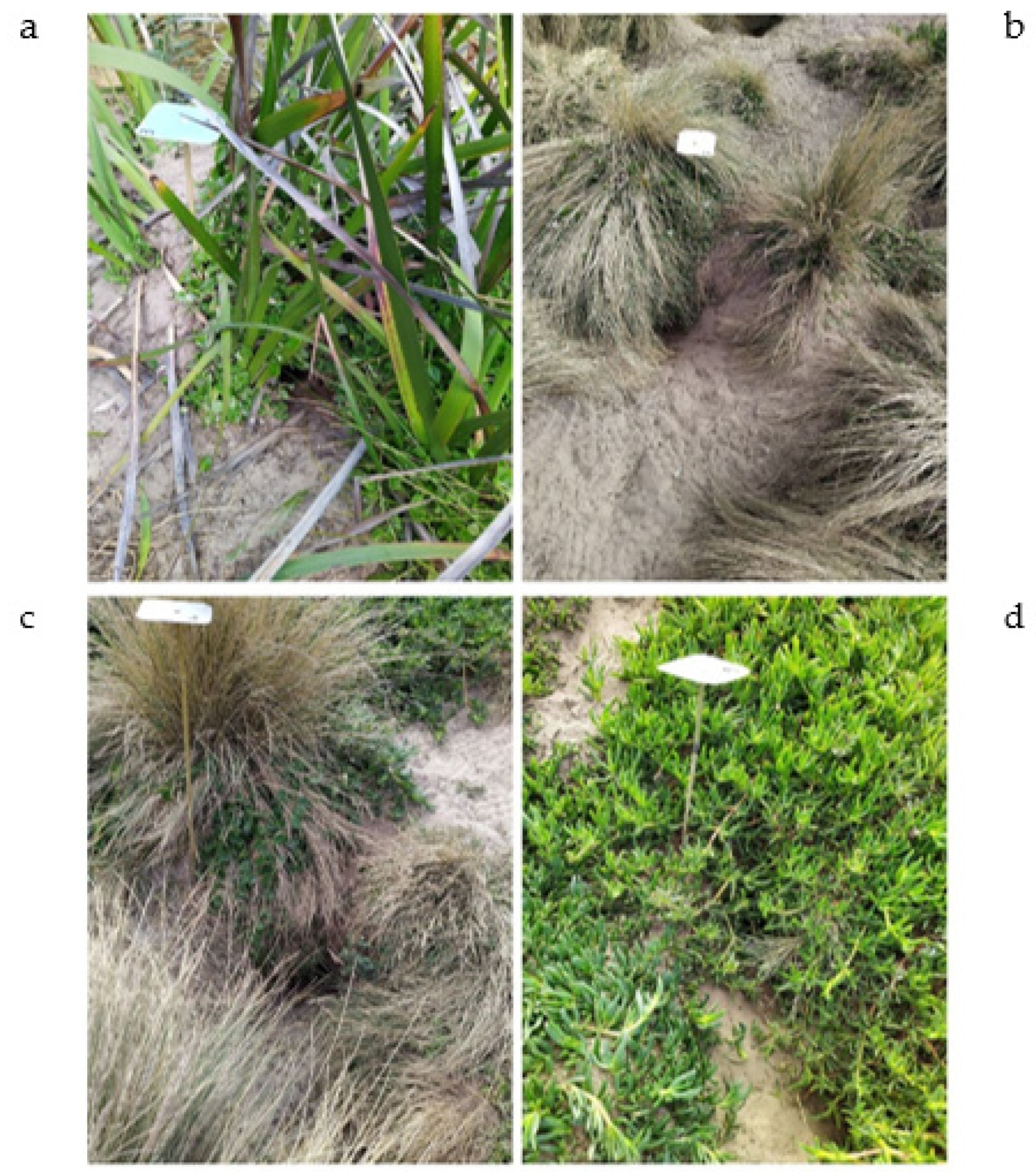
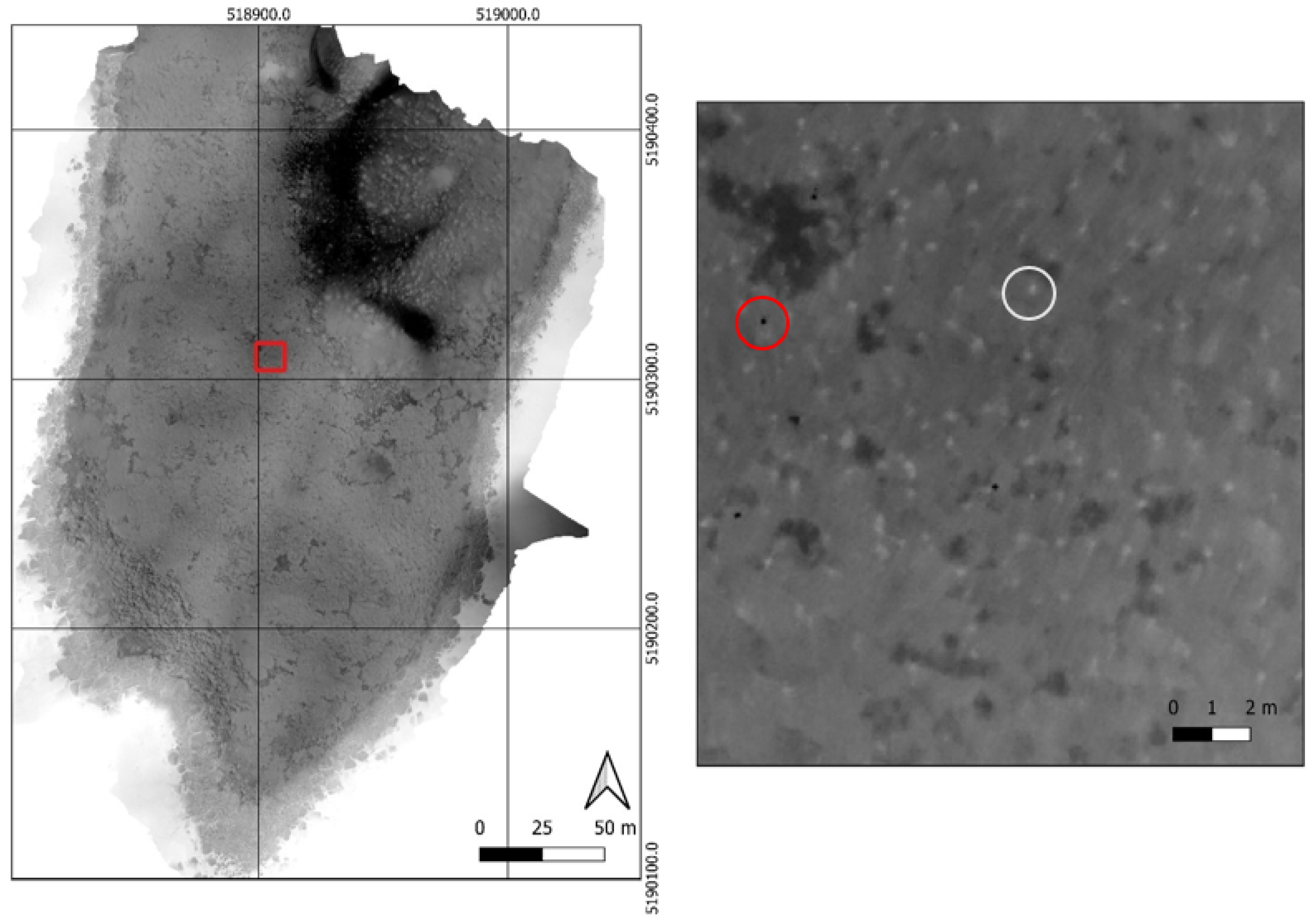

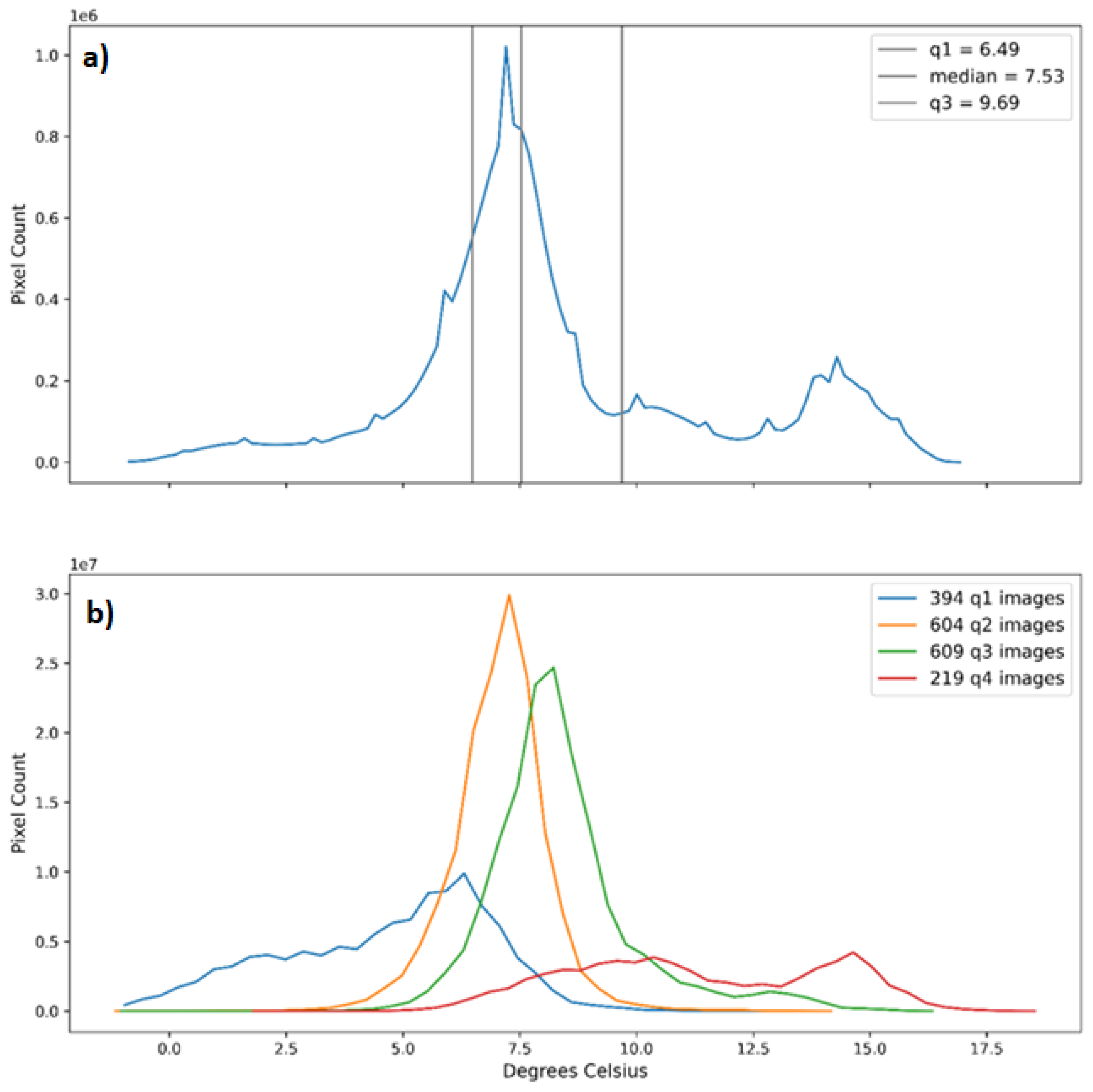
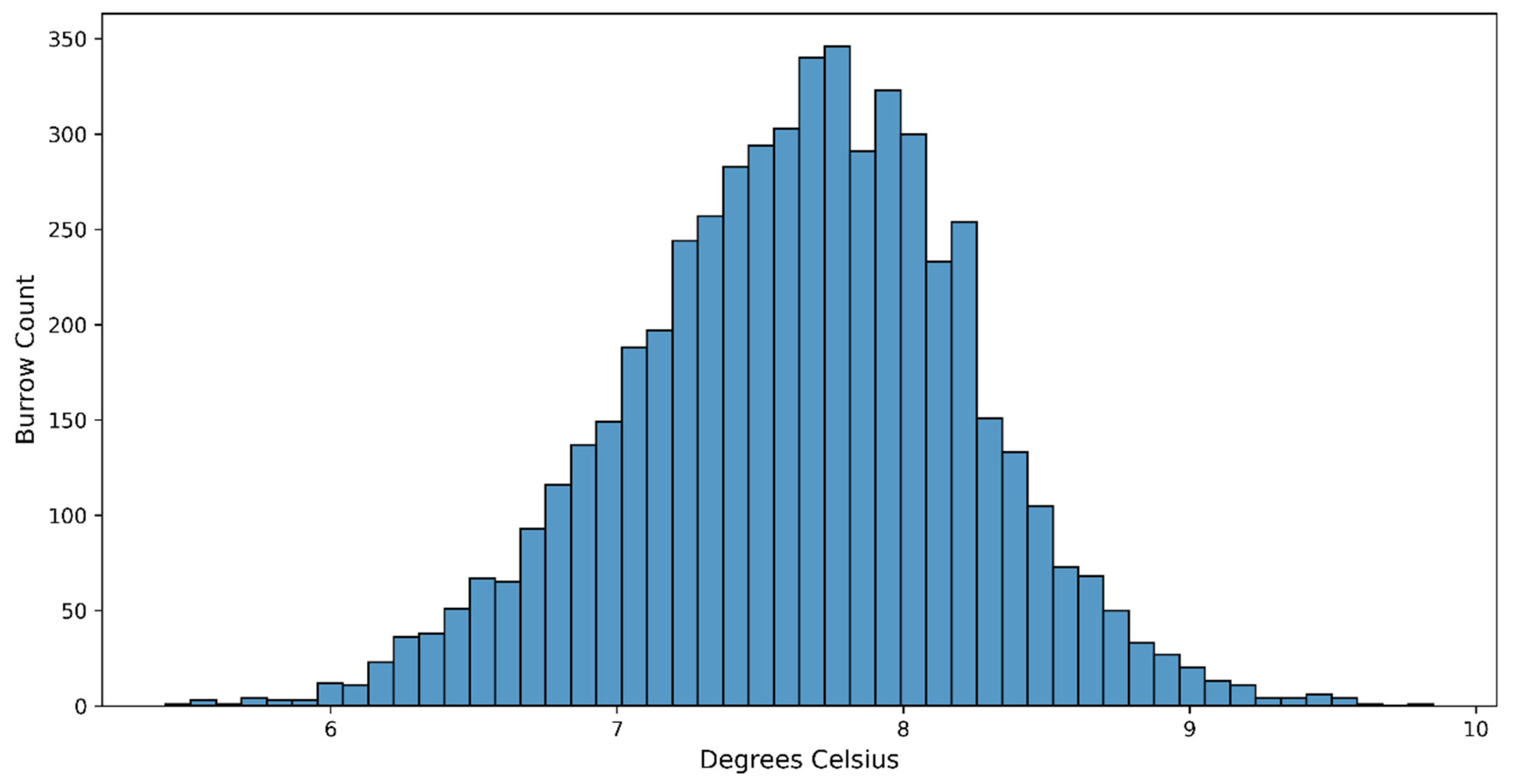
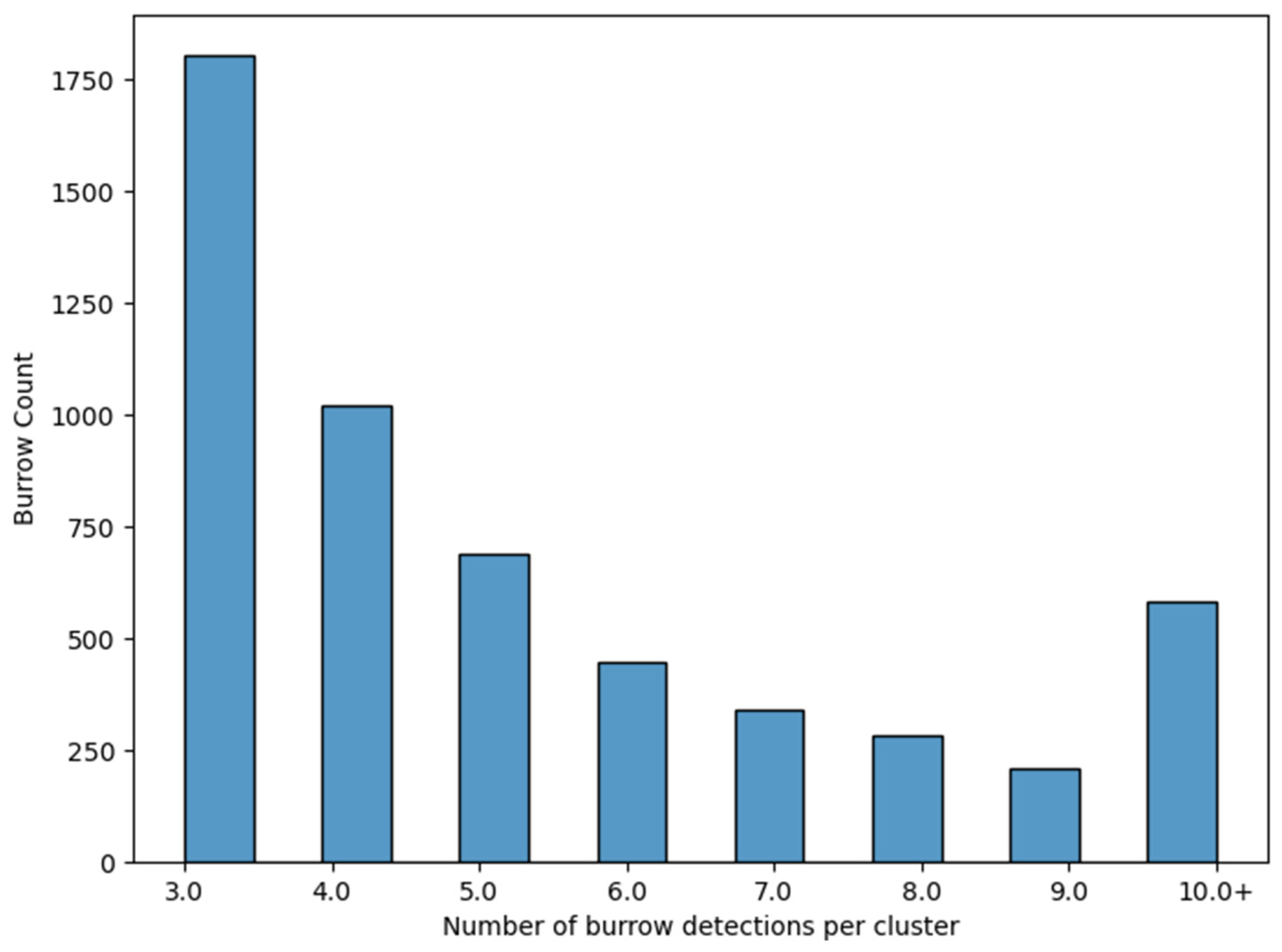
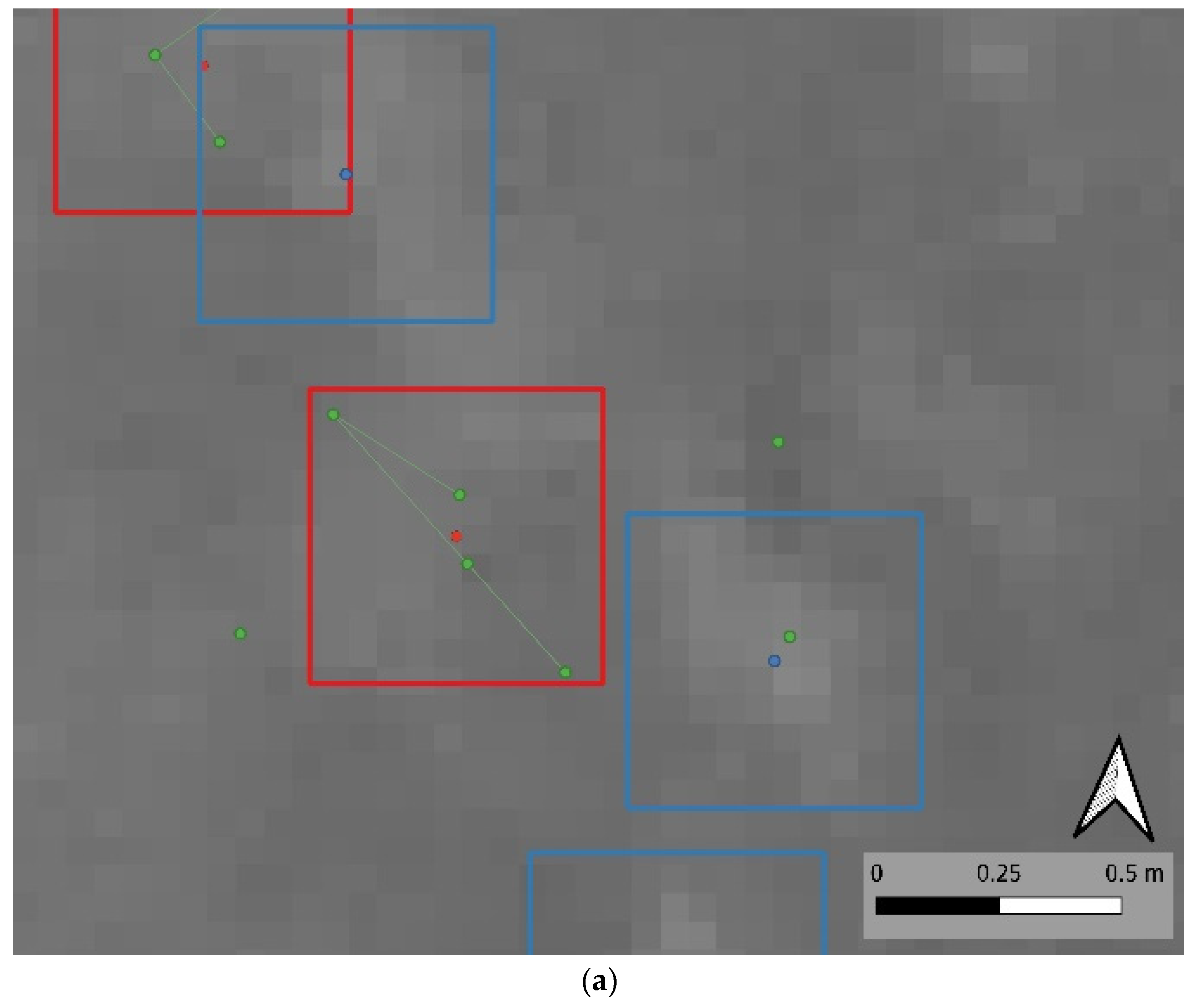
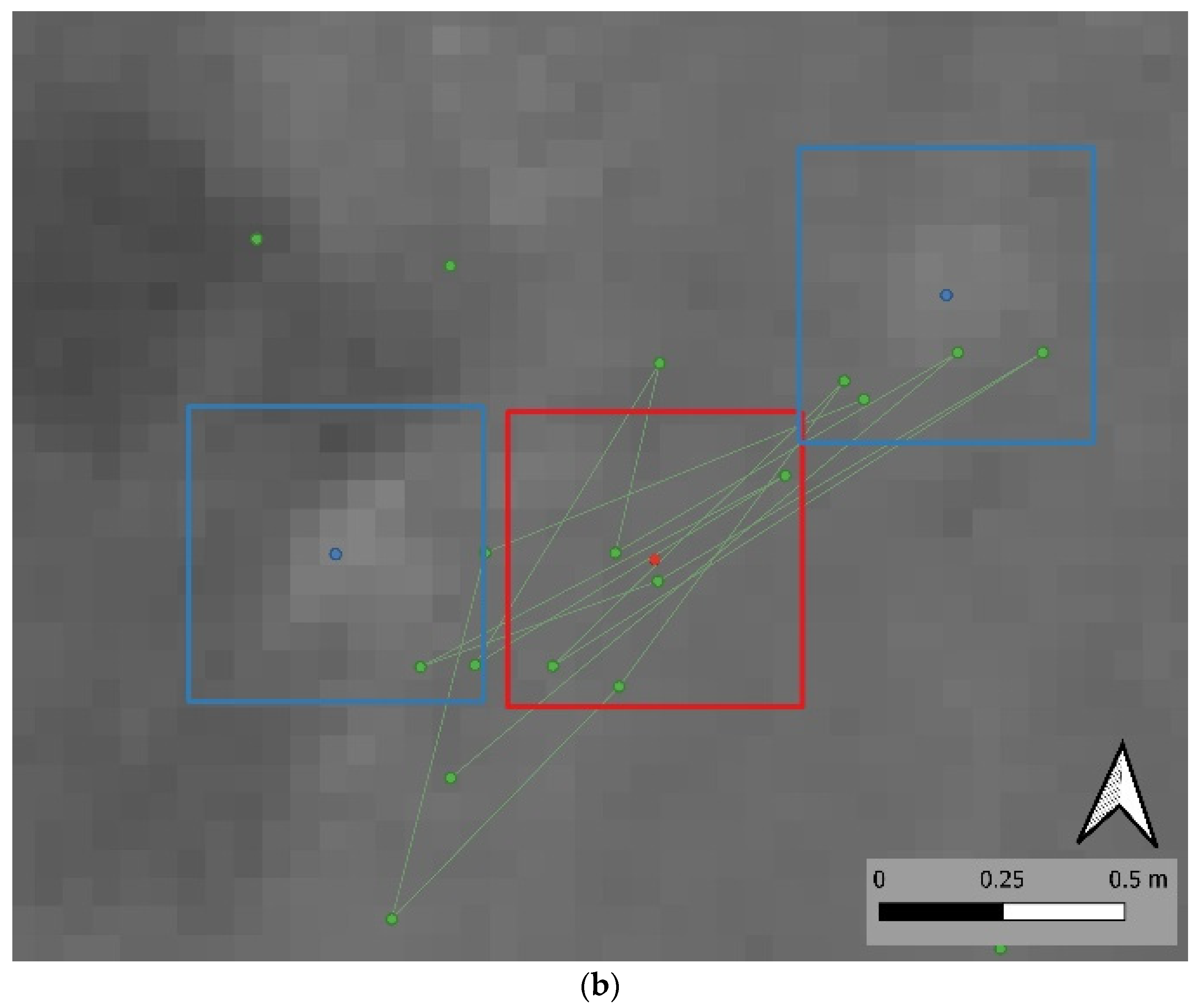

| Burrows Counted | Time Taken (Minutes) | |
|---|---|---|
| Automated Count | 5787 | 10 |
| Manual Count | 5249 | 210 |
| Predictions | |||
|---|---|---|---|
| 0 | 1 | ||
| Actuals | 0 | − True Negatives | 538 (9%) False Positives |
| 1 | 1266 (22%) False Negatives | 3983 (69%) True Positives | |
| Score | |
|---|---|
| Accuracy | 0.69 |
| Precision | 0.88 |
| Recall | 0.79 |
| F1 | 0.82 |
Disclaimer/Publisher’s Note: The statements, opinions and data contained in all publications are solely those of the individual author(s) and contributor(s) and not of MDPI and/or the editor(s). MDPI and/or the editor(s) disclaim responsibility for any injury to people or property resulting from any ideas, methods, instructions or products referred to in the content. |
© 2023 by the authors. Licensee MDPI, Basel, Switzerland. This article is an open access article distributed under the terms and conditions of the Creative Commons Attribution (CC BY) license (https://creativecommons.org/licenses/by/4.0/).
Share and Cite
Virtue, J.; Turner, D.; Williams, G.; Zeliadt, S.; Walshaw, H.; Lucieer, A. Burrow-Nesting Seabird Survey Using UAV-Mounted Thermal Sensor and Count Automation. Drones 2023, 7, 674. https://doi.org/10.3390/drones7110674
Virtue J, Turner D, Williams G, Zeliadt S, Walshaw H, Lucieer A. Burrow-Nesting Seabird Survey Using UAV-Mounted Thermal Sensor and Count Automation. Drones. 2023; 7(11):674. https://doi.org/10.3390/drones7110674
Chicago/Turabian StyleVirtue, Jacob, Darren Turner, Guy Williams, Stephanie Zeliadt, Henry Walshaw, and Arko Lucieer. 2023. "Burrow-Nesting Seabird Survey Using UAV-Mounted Thermal Sensor and Count Automation" Drones 7, no. 11: 674. https://doi.org/10.3390/drones7110674






